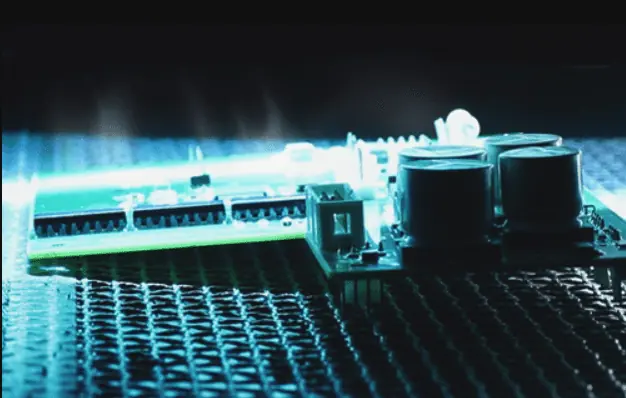Dymax discusses the importance of ASTM E595 outgassing testing for light-curable materials used in the production of parts for avionics and optoelectronic applications.
As a leading manufacturer of UV/LED light-curable materials that meet ASTM E595 standards, Dymax understands the critical importance of reassuring manufacturers that finished components meet critical standards.
What is Outgassing?
If a gaseous vapor is being emitted from the adhesive or coating on your part during the light-curing process or when exposed to extreme conditions after cure, you are likely seeing the phenomenon called outgassing or off-gassing.
When very rapid polymerization or chemical reaction occurs, the chemistry exposed to light energy, heat, and/or vacuum, may release a small amount of gas that was trapped, absorbed, dissolved, or frozen before the material was completely cured. Moisture inherent in the raw ingredients will typically make up most of the outgassed compounds. There may also be ppm levels of impurities from the raw ingredients and/or trace amounts of unreacted monomers. The result of this outgassing might be unintentional weight loss or deposition of material onto surfaces, both of which could interfere with proper operation of finished components.
Outgassing in Light-Curable Materials
Testing light-curable materials for outgassing is critical for many reasons, the most obvious being potential contamination of the end-use environment a particular part may be used in.
Outgassing or vapor deposition may also be concerning for any of the following reasons:
- Indication of decomposition or change in the structure of a substrate, coating, or adhesive
- Contamination of surfaces which must remain clean to retain their electrical properties
- Warning of potential corrosion, plastics crazing, or other surface weakening mechanisms
ASTM E595 – Outgassing Test
One widely used outgassing test is ASTM E595 – sometimes referred to as the NASA Low Outgassing Specification. It is often required by manufacturers to specify an adhesive or coating for their process, such as in the assembly of printed circuit boards for optical, electronic, and aerospace/defense applications.
ASTM E595 testing is run at 125°C (257°F) under a 5 X 10-5 Torr vacuum for 24 hours. The Total Mass Loss (TML %) and Collected Condensable Volatile Material (CVCM %) are measured. Water Vapor Regain (WVR %) is also reported.
TML is the percent of the sample’s weight loss during testing and should be <1.00% to meet the specification. CVCM is the percent of outgassed compounds from a sample that condenses onto a collector during the testing with a threshold of <0.10%. WVR is not typically used as a pass/fail criteria for ASTM E595 but can help demonstrate what percent of the TML can be attributed to water vapor.
Avionics & Optoelectronics
For avionics or optoelectronic applications, CVCM is most critical as it might indicate material is being deposited onto optical parts in unintended areas, or that the parts could fog or even lose electrical continuity. Under room temperature conditions, proper ventilation or air circulation near the curing operation will help to mitigate outgassing redepositing onto parts, but this is a greater challenge under vacuum.
Testing for outgassing can be a crucial step to reassuring manufacturers that their finished components meet critical standards and help reduce the potential for part failure.
Dymax has a selection of light-curable materials that meet ASTM E595 standards as well as a wide range of products that have low TML and CVCM properties.











